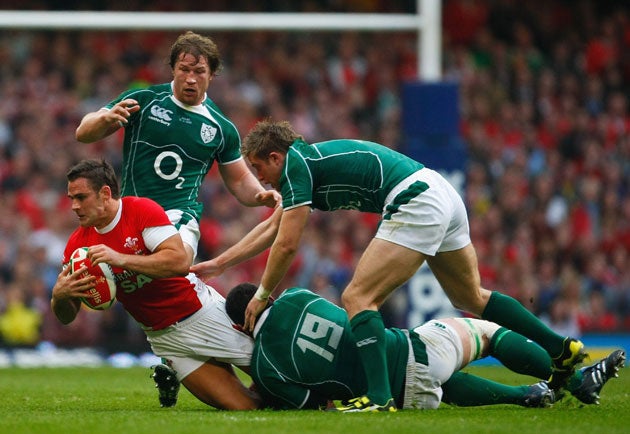ELVs reveal startling statistics

Some extraordinarily revealing figures about modern day rugby which go a long way to explaining many of the problems in the game will be presented to an IRB conference on the new ELVs in London next week.
Arguably the most microscopic examination of the game ever undertaken has shown that the breakdown, enshrined in the rules of the game as a contest for the ball, has become almost anything but. During the 2007 Rugby World Cup final, the retention rate of possession by the two teams going into contact at the breakdown was an incredible 95 per cent. Over that tournament as a whole, a retention rate of 92 per cent was discerned.
One leading IRB official called the figures "truly scary" and rightly so. They threaten the whole future of rugby union as a game for all shapes and sizes, as defined in its charter. The reason is, if ball possession is guaranteed at the breakdown, players of a uniform height and weight will emerge, as in rugby league. The need for smaller men like flankers, who are able to win the ball on the ground, will gradually die out.
But what that reality led to were further statistics which explain with brutal clarity why there is so little space available in the modern game for attack minded teams. The survey showed that in the 1970s, on average, there were around 50 rucks and mauls in a game. Those points of the breakdown attracted, again on average, 6-7 attacking players and 5-6 defenders.
That figure has mushroomed to anything between 150 and 190 rucks and mauls in the modern game. But most crucially, the numbers for attacking and defending players at the breakdown tell their own story. On average in the modern game, researchers have found that just 3.3 attacking players commit to the breakdown. The number of defenders is frightening, just 1.2.
These figures explain perfectly why the modern day rugby field is cluttered with players. With so few committing to the breakdown, the rest are lined out across the field in rugby league style, simply waiting to knock down the ball carrier. At that point of breakdown, equally few numbers commit which means sides often need 17 or 20 phases to make a decisive breach in the opposition defence.
Thousands of games, played in countries as diverse as Scotland, Australia, South Africa and New Zealand have been videoed and analysed to produce these figures. In those countries at certain levels, the full set of ELVs have been trialled, with aspects such as an offside line at the breakdown, allowing hands in the ruck and the short arm free kick rather than full penalty for a raft of offences.
What those trials have shown is that the retention rate for the ball carrier going into the breakdown drops to 85 per cent or less, thereby moving the game slightly closer to a contest for possession. And numbers of defending players have increased at those breakdowns.
The tragedy is that all those ELVs which could make a really significant difference to the game by freeing up more space look almost certain to be thrown out when the IRB Council makes a final decision probably late next month.
This is because the northern hemisphere put its heads in the sand and flatly refused to countenance trialling the more controversial but potentially more advantageous aspects of the ELVs. I understand even the ELV under which teams are allowed to collapse the maul, is not likely to be sanctioned. Yet despite the original law under which the rolling maul could not be collapsed, as many as 71 per cent were, showing that illegalities flourished.
Critics, mainly in the northern hemisphere, claimed there would be many more injuries if mauls were allowed to be collapsed. But after two years, that doesn’t appear to be the case.
All the game is likely to be left with after four years of trials in various countries around the world is a few watered down, largely inconsequential laws such as allowing players to throw the ball straight back to a colleague rather than forming a full line-out, not allowing the ball to be passed back into the 22 and then kicked into touch on the full and forcing defences to retreat an extra 5 metres at set pieces.
But this would be merely tinkering with the problems. It would also leave the game stuck with the ghastly sight of unadventurous players and terrified coaches scared of losing a game and maybe their jobs just relentlessly kicking the ball backwards and forwards downfield to avoid taking the slightest risk.
Australian Rod Macqueen, who was one of the original rugby men asked to draw up a list of potential law changes, said "You can’t blame these new trialled rules for the decision of coaches and players to be ultra conservative. Equally, it will be very difficult to make a definitive judgement on these ELVs because the whole principle of the Laws Project Group was that the laws should be trialled worldwide in full, so that an assessment could be made based on fact, not perception.
"Sadly, that has proved impossible to achieve."
Macqueen says he holds no particular candle for any law. He and his colleagues on the Laws Project Group were appointed and simply asked to investigate some proposals which might or might not prove beneficial.
But many people will draw the sad conclusion that if the more innovative of these ELVs are jettisoned the game will have lost a glorious opportunity to move forward into a 21st century sport synonymous with professionalism and entertainment, able to attract a new audience.
Join our commenting forum
Join thought-provoking conversations, follow other Independent readers and see their replies
Comments
Bookmark popover
Removed from bookmarks